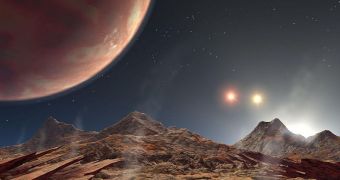By browsing large survey databases from the Virtual Observatory, a group of experts managed to discover a new cataclysmic variable (CV), a class of cosmic events that are also called “novae.”
Astronomers Ivan Zolotukhin and Igor Chilingarian, the leader of the research effort, explain that novae are in fact binary star systems, in which the two stars either revolve around a common center of gravity, or a smaller one orbits its larger counterpart.
In order for such a system to be classified as a nova, it needs to meet certain criteria. The most important one is mass transfer between the stars, Universe Today reports.
Generally, this occurs as a post main-sequence star sheds some its matter, which is then accreted by its companion, which experiences a boost in brightness as a direct consequence.
This process goes on until the star accreting the matter reaches a density threshold beyond which it becomes unstable. Once this happens, an intense fusion reaction takes place that further increases the brightness of the star.
One very important thing about instances such as this one is that the core of the star accreting the mass does not reach the critical density that is needed for it to collapse into a neutron star or black hole.
In the new investigation, the group browsed through the results obtained by the Advanced Satellite for Cosmology and Astrophysics (ASCA) Galactic Plane Survey, settling on investigating about 107 space bodies.
All of these structures emitted vast amounts of X-rays, but defied classification in previous research efforts. Using the Virtual Observatory, the team attempted to determine whether any of these objects were CV.
One of these celestial bodies appeared to be the type of CV they were looking for, but the team could not be sure based only on available data.
So they turned to data collected by surveys carried out using the Chandra X-ray Space Observatory. By overlapping the two surveys, the researchers found that two X-ray sources were emitting radiation from the same region of space.
They then proceeded to determine whether the stars were just lying nearby, or if they were in fact part of the same system, which would have enabled the astronomers to classify then as a nova.
In the end, it was revealed that the object the Isaac Newton Telescope Photometric Hα Survey of the northern Galactic plane (IPHAS) initiative had identified was part of the same system as the object in the ASCA survey.
But the system has a twist. The primary white dwarf star in the binary has a magnetic field that is so strong it disrupts the accretion disk. This means that the point of contact between the two stars is above the poles.
The discovery again highlights the fact that discoveries are at hand without having to need other telescopes. Mining available data for correlations may still yield numerous, significant findings.

 14 DAY TRIAL //
14 DAY TRIAL //